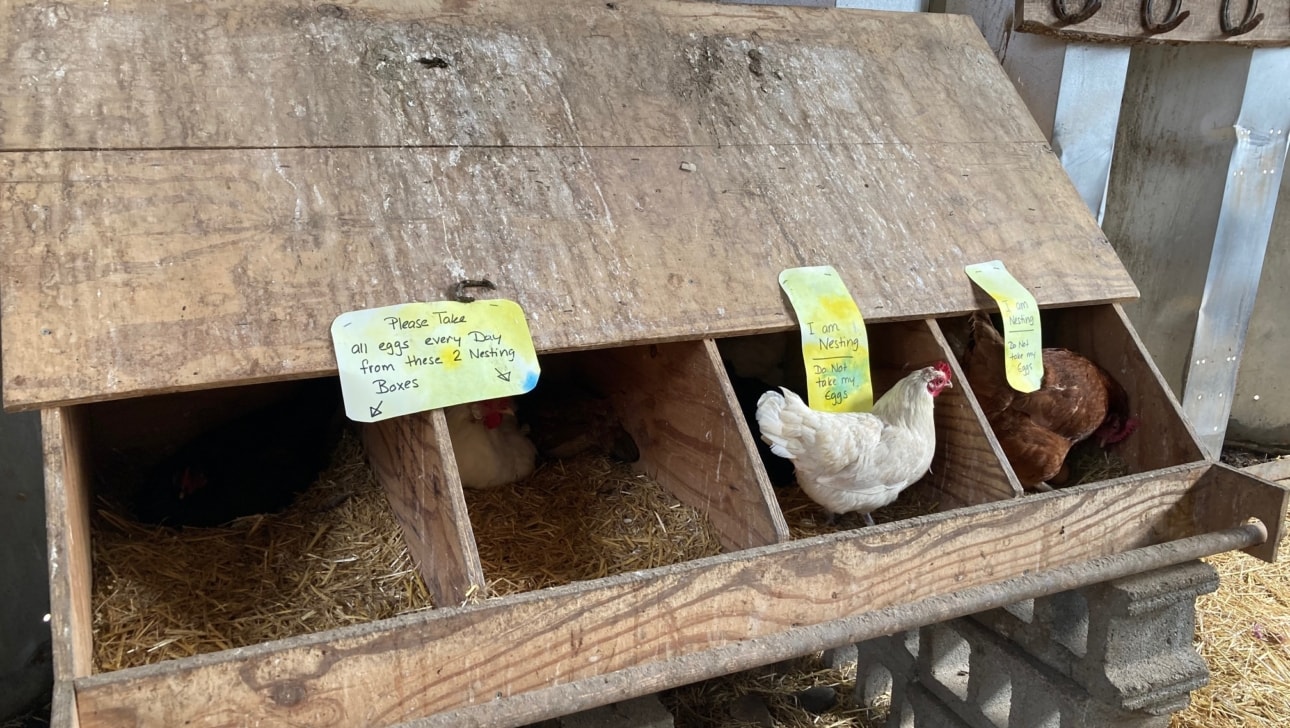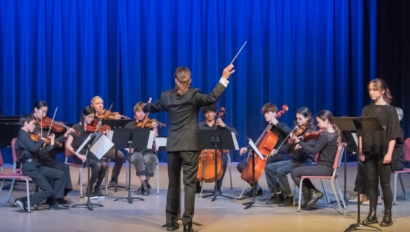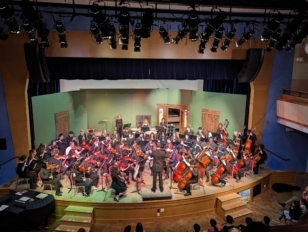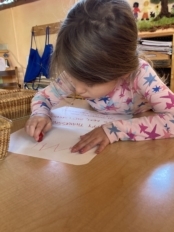A Story from the Barnyard
by Carol Grieder-Brandenberger Farm Kindergarden Teacher
Rooster Thunderbolt is a kind and handsome rooster who lives in the Duryea Farm Kindergarten barnyard. This rooster along with two beautiful shiny black chickens always join the class during snack and lunchtimes. Thunderbolt crows loudly during the stories we share with each other, and calls to the chickens to eat the tidbits that might fall on the ground. He is a considerate rooster, always making sure everyone is fed, before eating himself. We have named Thunderbolt and the chickens “the cleanup committee,” because they always keep the tent area clean during our mealtimes.
After a time, we noticed that Thunderbolt joined us alone during snack and lunch times. Where were his two companions? We discovered that the two chickens were nesting and sitting on their eggs, one in the hay rack in the sheep barn, and one in an unknown hiding spot. The reason we knew she was nesting was that she appeared every day in the barnyard around noon to hastily eat a snack of chicken food and drink some water and to take a sand bath, all the while flapping her wings and clucking in a way that only nesting chickens do. Once her meal was completed, she quickly ran to her hiding spot once again, before we could follow to find out the location.
One day all of this changed, when Gabriel Pantoja, one of our kindergarten teachers, found the hiding spot. The chicken was nesting in the horse pen, tucked in a corner, hardly visible. Unbeknownst to any of us, this was the nesting spot our beautiful little black chicken had chosen. However, there was a problem with that nesting spot. Though it is very safe from predators, there is no doorway for the chicken family to get out of the horse pen, once the baby chicks have hatched. Though the mother hen can fly in and out of the horse pen, the baby chicks would not have been able to exit.
I opened the door to the horse pen and carefully examined the nest. It was immediately clear that mama chicken had many little baby chicks under her wings; a few of them were poking their heads out curiously. When I lifted her wings gently, I saw many tiny beautiful black fluffy baby chicks and one tiny little yellow one.
While mama chicken and her chicks were safe for the moment, they would not be for long. We knew that she could not be left in a space without water and food and without being able to walk her babies back to the barnyard. The teachers spoke together and decided that “moving day” for the chicken family had arrived!
With the help of one of the children, we first mucked the chicken pen and scattered fresh straw to create a new and fresh nest for the chicken family. Then we set up the special little indoor cage and placed a water and baby chick feeder into the little cage which would serve as a safe space for the mama chicken and her babies. Finally, we called all children to stand at the fence to watch, reminding them of the importance of calm voices, so the chickens would not be scared during the move.
Gabriel Pantoja opened the horse pen door, and I carefully picked mama chicken up off her babies. She was surprisingly calm. She watched in the safety of my arms all the while making soft clucking noises, while Emoke Schulthess, another kindergarten teacher, scooped up all the little baby chicks into a bucket. The kindergarten children were delighted to see the chicks and were able to watch while we lifted them all into their safe little home in the chicken barn. We could even hear the piping noises in the egg from which one baby chick was still hatching and had not yet emerged.
Mama chicken quickly gathered all her babies under her wings and seemed happy to be in her new home. With her beak she popped the one little egg under her body that had not yet hatched to keep it warm. The baby chicks were happy to have some food to peck and some water to drink and then settled down under the chicken’s wings to take a rest. And with the barn door open, Thunderbolt also entered the chicken barn to check on her, and seemed happy to see that the chicken and baby chicks were happy and safe.
All was well in the barnyard!
Postscript and Thoughts for Adults Only:
The Power of Stories: I imagine the children have come home with the story about moving day. Such are the stories we experience in farm kindergarten, they are “living stories,” which come alive, because we have lived them together. Through these stories the children experience joy, reverence, gratitude, compassion, courage and commitment to caring for others and the natural world around them. What are the living stories we share in our homes with our families, about our childhood, and about caring for others? We can think about how we can nourish our children’s lives with oral storytelling in our homes, to create a foundation for literacy and for building the human skill sets that are so important for their lives.
Fun Facts: During lunchtime, the children had many reflections and were looking forward to telling their parents about the baby chicks: “We will have to tell our parents about it,” one child said. Another child wondered if she should not tell her parents: “My parents will want to come right up to the barn to see the babies, instead of going to work.” And as it is, the children have advice for each other. A child quickly offered a solution: ”Don’t tell them!”
Correct and Helpful Terminology: Even for very young children, stories about animals offer opportunities to consciously use correct and helpful terminology regarding reproduction and other topics surrounding life and death. Conversations about mating, nesting, and fertility find a simple and fertile ground in animal stories, and by using terminology correctly and carefully, children realize that they can speak with their grownups about anything, and it helps to weave trust for further conversations as children grow through childhood and adolescence, when being in conversation with children and young adults is so essential.



